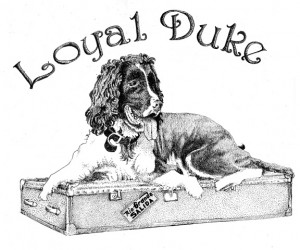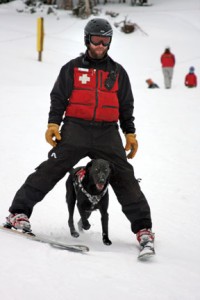By Hal Walter
Years ago, when Ed and Martha Quillen were conspiring to start a magazine called Colorado Central, we met for a greasy hamburger at a saloon called Susie’s in Westcliffe. As I recall it was a slightly chilly day, and afterward we were standing outside in the street with Ed gesturing his speech with both arms and a cigarette in one hand.
That was about when I saw the black beast trotting right down the middle of the near-deserted street through the one-block downtown district. As the canine critter drew near, its eyes bright and tongue lolling from side to side, Ed became aware that I was being distracted, and was watching something moving behind him. He turned as the animal passed and stood silent with both arms frozen outward in exclamation. The smoke curled up from the cigarette as the animal just trotted on by.
“Excuse me, but that was a wolf?” Ed turned and said with a tone that was both statement and question at once.
“Oh yeah,” I replied calmly and matter-of-factly, as if wolves trotting through downtown were a normal, everyday occurrence around here. After all, I wanted to give Ed the impression the area was interesting enough to support a columnist.
The truth was the black wolf was the first such animal I had seen running loose in Custer County, but it would not be the last of which I heard or saw.
It’s important to note that these wolves are not likely wild wolves but rather domesticated wolves or wolf-hybrids that have been turned out by humans. While animal expert Temple Grandin, author of “Animals Make Us Human,” says all dogs have evolved from wolves, these domesticated wolves and hybrids that I’m talking about have many of the physical characters of their wild counterparts.
Over the years I’ve heard other shaggy dog stories from reliable sources. The crew at Bear Basin Ranch saw a wolf on pack trips to Banjo Lake high in the Sangre de Cristo range. My friend Rob Pedretti, a hunting guide and houndsman, saw a wolf just off Hayden Pass. For many years there were reports of a big yellowish feral dog taking down deer in the Bear Basin Ranch area where I live.
Two winters ago while driving to Westcliffe, my wife Mary and I spotted two wolves eating something dead just off the south side of Highway 96. We pulled over and looked at them. One was black and the other yellowish. I later called then local Division of Wildlife officer Becky Manly, and she said she’d received other calls about that pair. In the following weeks there was a report in the Wet Mountain Tribune that Becky had indeed shot two wolf hybrids that were harassing livestock in the Wet Mountain Valley.
After Becky transferred to Kremmling, Justin Krall took over as our area DOW officer. He says he’s recently fielded reports of two wolfish dogs off Highway 96 near Bear Basin Ranch, and also said someone last summer reported a wolf chasing elk in the Macy Lake drainage in the Sangre de Cristos.
“Typically what we find is that they are hybrid wolves that people have had as pets, and they don’t work out as a pets, so they kick them loose,” Krall says. “Some of the ones that have been killed have been neutered or have had collars, so it indicates they’ve been domesticated.”
Krall says that once in the wild, these wolves and hybrids easily revert to wild behavior. “They’ve got that in them,” he says.
While there haven’t been any incidents of dangerous encounters by humans, Krall said reports of these wolf-dogs chasing wildlife and livestock are fairly common.
Another concern that nobody seems to know much about is the notion of these wolves or hybrids possibly interbreeding with coyotes. In a normal wild setting wolves would be the natural enemy of coyotes, but scientists say DNA evidence indicates wolves and coyotes have interbred in Canada and the Great Lakes area of the United States.
Our Western coyote is generally considered a predator of small animals. However, in recent years I’ve personally witnessed a large coyote running away from a freshly killed doe and a pack of coyotes taking down a deer. It makes me wonder if there’s something else going on.
Removing domesticated wolves and hybrids from the environment is tricky says Krall, because wild wolves are protected in Colorado, and though they are considered extinct here, the state lies between the habitat for the Mexican gray wolf to the south and the native wolves of Wyoming and Montana. There’s a chance a true wolf might wander into this area. In fact one wolf from Yellowstone was killed by a motorist on I-70 in 2004, and another from Montana was found dead near Rifle earlier this year.
Krall suggests people who encounter wolf-like canines in the wild take photos so that officials can determine whether they are dealing with a true wild wolf or a domesticated wolf or hybrid.
Two summers ago I was training a burro on the Rainbow Trail south of Alvarado Campground. I rounded a corner and standing uphill, looking down at me, was a big yellow wolf hybrid, heavy on the wolf genes. We stopped and looked at each other and then were met by two trail runners who asked if this was my dog. It had apparently been running with them for some time.
As I went past, the wolf-dog decided it was now my turn. This was a long-run day and the wolf-dog ran with me and Laredo for more than four hours. I use the term “with” quite loosely, for I am sure it ran three or four times as far as we did, passing back and forth across the trail, up and down the hill to either side.
When I got back to the trailhead the yellow wolf jumped into my pickup bed as I loaded the burro. When I insisted he get out, he followed my truck back out of the trailhead to the road. Only when I hit pavement was I able to gain enough speed to shake him. I could not imagine how any human could possibly provide such an animal with sufficient physical activity.
I went to town and called one of the local animal rescue people, who in turn contacted a woman who lives in the area and keeps wolves. Last summer I saw this woman in town and she said she still has the yellow wolf-dog.
On Thanksgiving morning while out for a run near here I saw off in a field what I first thought was a coyote. The animal turned to face me and I noted its height was more like that of a small deer. A magipe was harassing the canine and it jumped at the bird. Then it turned and took notice of me jogging on the road maybe a quarter-mile away.
The critter trotted up the hill, where it turned broadside to look back at me. Then it turned away and disappeared over the hill.
Another wolf on the loose? It sure looked like one to me.
Hal Walter writes and edits from the Wet Mountains. You can keep up with him regularly at his blog: www.hardscrabbletimes.com

